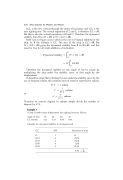Page 232 - statbility for masters and mates
P. 232
220 Ship Stability for Masters and Mates
B2Z1 is the new vertical through the centre of buoyancy and GZ1 is the new righting arm. The vertical separation of Z and Z1 is therefore GZ dy. But this is also the vertical separation of B and G. Therefore the dynamical stability from y to (y dy) is W (GZ dy).
Refer now to Figure 22.2(c) which is the curve of statical stability for the ship. At y the ordinate is GZ. The area of the strip is GZ dy. But W (GZ dy) gives the dynamical stability from y to (y dy), and this must be true for all small additions of inclination.
O
Therefore the dynamical stability to any angle of heel is found by multiplying the area under the stability curve to that angle by the displacement.
It should be noted that in ®nding the area under the stability curve by the use of Simpson's Rules, the common interval must be expressed in radians.
or
degrees by 57.3.
Example 1
A ship of 5000 tonnes displacement has righting levers as follows:
Angle of heel 10 20 30 40 GZ (metres) 0.21 0.33 0.40 0.43
Calculate the dynamical stability to 40 degrees heel.
GZ SM Functions of area
010 0.21 4 0.84 0.33 2 0.66 0.40 4 1.60 0.43 1 0.43
3:53 S1
; Dynamical stability
W
W GZ dy y
GZ dy
57:3 1 radian
1 1 radians
y O
57:3
x x radians
57:3
Therefore to convert degrees to radians simply divide the number of


